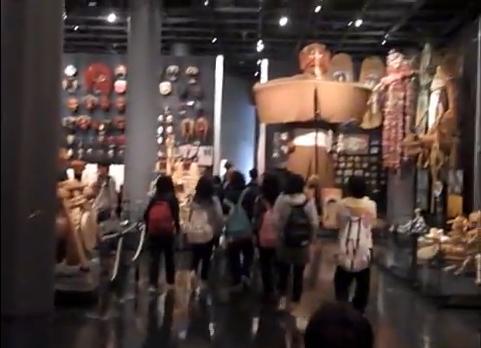 OIS関西学院大阪インターナショナルスクールの小学部低学年生たちが民博を訪問しました。OISは箕面市小野原にあるアメリカンスタイルの学校で幼稚園から高等部までがあり、4歳から18歳までの子ども達が学んでいます。
OIS関西学院大阪インターナショナルスクールの小学部低学年生たちが民博を訪問しました。OISは箕面市小野原にあるアメリカンスタイルの学校で幼稚園から高等部までがあり、4歳から18歳までの子ども達が学んでいます。
探求心を伸ばそうとする教育方針から学校外へ出かける機会も多く、一番近い博物館である民博は生徒たちに絶好の校外学習の場になっています。なので民博にはスクールバスでお弁当もってしょっちゅう来ます。
今回は小学部一年生たちが、housingというキーワードで学んでいる社会学習の一端として博物館とはどのようなところか?を知るための見学です。
民博側からはニュージーランド出身の民族植物学者で研究員のピーター=マシューズ先生が案内役を買ってでて、引率の先生たちとともに生徒たちの活発で時々荒唐無稽な質問を楽しみながら、キーワードに即した展示の数々を効率よく楽しく案内しました。
特に実際の家屋を移設して展示している韓国の家に入ってオンドル設備のある居間に座ったり、モンゴルのゲルに入ったり、精巧にできた東アジアの民家のジオラマ模型を見たり、他の博物館には無いリアルで体験的な博物館展示を、生徒たちは文字通りカラダで感じながら学んでいました。
引率の先生の感想では、6~7歳の子ども達が眼を輝かせて飛びついた展示は、実際に中に入れる家や音を出したり身につけたりできる体験展示で、いかに精巧にできている模型でもガラスケースの中にあると一様に関心が薄いとのことでした。そういう点では、民博の展示は、彼らにとってテーマパークのような楽しさを味わいながら体験的に深く学ぶことができる遊びと学びを兼ね備えた教育施設としての可能性を大いに秘めているんだなと思えますね。
(Aki)
吹田市は国際性を目指すまちです。国際校の生徒にも来てもらい、学校や子供同士の交流もできるといいとおもいます。
(カンチョー)
How OIS is using Minpaku, What we want from Minpaku, For education – need to experience…
 Osaka International School is fortunate to be approximately 3 km from the National Museum of Ethnology. Students at OIS range in age from 4 – 18 years old but all are encouraged to be active, inquiring learners. Minpaku is a great resource for their learning.
Osaka International School is fortunate to be approximately 3 km from the National Museum of Ethnology. Students at OIS range in age from 4 – 18 years old but all are encouraged to be active, inquiring learners. Minpaku is a great resource for their learning.
Elementary education is theme-based so visits to Minpaku will involve the students connecting their classroom learning to what is in the museum. For example, a recent visit by first graders focused on the theme of housing. The children were shown around Minpaku by Peter Matthews. He took them first to the recently-constructed Korean house. Children considered how rooms were constructed and how each space would be used. They then made sketches of things in that house that interested them.
Next, we walked past the model of a Chinese Village. As this is behind glass and the wall of the village, the children were not particularly interested in this.
From there, Peter took them to the Mongolian Pao Tents. The children were very excited to feel the woollen walls and would have liked to go inside the tents.
(There are Pao Tents where people can stay on Naoshima Island)
Next stop was the Ainu house made of straw. The children connected this house with the famous story of the 3 Little Pigs. Peter Matthews told us of the Ainu builder who has a real fire in that house each year and the wood shaving decorations that show each visit. It is a little hard to imagine the staff turning off the fire alarms and pretending to be outside as they sit around the fire, but children have better imaginations than adults. Again, some children made sketches and asked Peter difficult questions such as why there were two dogs but no people in the Ainu village display.
Lastly, the children saw a houseboat and the shark fin hanging out the front interested them more than anything. Some models of people on the boat would have made it easier to understand the cramped conditions these people live in.
While we were there, we also admired the nearby store house with its fancy roof made of bamboo.
Upon returning to school, the students wrote about each house and their writing is displayed beside photos in the hallways. Next time they visit, their focus will be on something quite different. It could be on survival in different environments, clothing, festivals or some other topic. Having an English speaking curator is a huge bonus. It’s no wonder one first grader asked Peter Matthews if he was a king.
(H3 PO4)


コメント